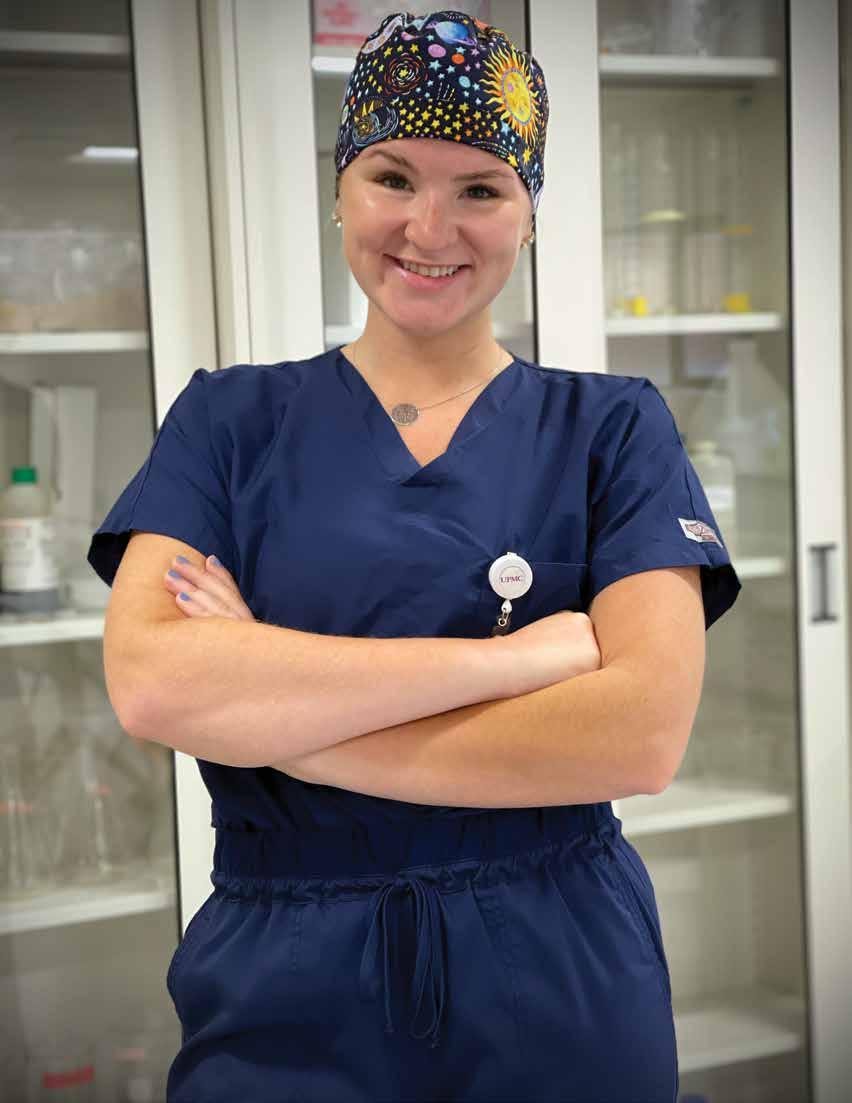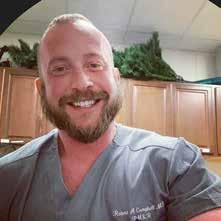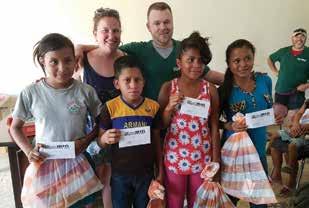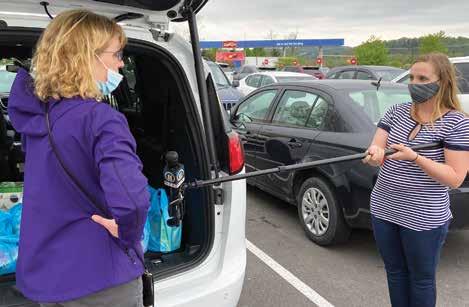
11 minute read
Look to the Titans
Mother Fair’s children find ways to be the helpers
Fred Rogers, whether speaking to children through the television set from his Mister Rogers’ Neighborhood studio or in interviews with adults, often mentioned that in times of tragedy or uncertainty, we should “always look for the helpers.” As the coronavirus pandemic has shown, the past year we’ve seen more than our fair share of tragedy and uncertainty. The year 2020 will be remembered as a bleak year of turmoil, sadness and anxiety as we faced unimaginable personal loss, financial hardship and the great fight to stay protected against a virus that knows no boundaries. But even in some of our darkest times, there have been moments of brightness. Moments of hope. Moments of selflessness. In many cases, as we’ve looked for helpers to care for and inspire us, we really needed to look no further than our own Titan nation.
WHEN I WAS A BOY AND I WOULD SEE SCARY THINGS IN THE NEWS, MY MOTHER WOULD SAY TO ME, 'LOOK FOR THE HELPERS. YOU WILL ALWAYS FIND PEOPLE WHO ARE HELPING.'
FRED ROGERS
Westminster students and alumni approach the world with care and compassion, and this past year has been no exception. We’ve heard stories of frontline heroes, mask makers, food bank workers, virus tracers, pharmacy technicians—when uncertainty and tragedy struck, the people of Westminster stepped in. They were ready to be the helpers. They were ready to offer hope.
Claudia Kamenski ’21, a student in Westminster’s nursing program, was in the middle of her junior year and getting ready to graduate from the UPMC Jameson School of Nursing when the COVID crisis began. After isolating like everyone else and finishing up her coursework virtually, Kamenski took her nursing boards in June 2020 and shortly after began working as an operating room nurse at UPMC Jameson.
As a freshly minted registered nurse, jumping from It has been a scary clinicals straight into a hospital operating room in the middle of time to work in an unpredictable pandemic was such a vulnerable a bit trial by fire.
“I never expected that a environment. But I global pandemic would impact am grateful for the my career, especially when just starting in this position,” experience of helping said Kamenski, who earned her Bachelor of Science in Nursing those who are sick (BSN) from Westminster and vulnerable. in May. “We are reminded constantly in nursing school that nurses must be flexible, CLAUDIA KAMENSKI '21 and this was the perfect example of that and a reminder to remember why we chose to work in this field.”
But Kamenski hit the ground running. She felt prepared, safe and healthy—and even understanding the potential for COVID exposure as a frontline healthcare worker, she knew helping was more important. It was what she was born to do.
“It has been a scary time to work in such a vulnerable environment,” she said, admitting that working daily with COVID patients has add extra stress to her job. “But I am grateful for the experience of helping those who are sick and vulnerable. Ultimately, I am a young and healthy person and I have no problem putting myself at risk over an older coworker or a coworker who has at-risk family members at home.”
W
Dr. Bobby Campbell ’03 also recognized the risks brought on by the pandemic, but as a physiatrist, he knew that caring for his patients at the Pain Care Center in Lander, Wyo., took precedence. His patients’ pain didn’t stop just because of coronavirus, and he knew he needed to help.
“Our patients have acute and chronic pain and a majority of them are debilitated by their symptoms,” said Campbell, who performs interventional procedures such as spinal nerve root blocks, spinal cord stimulator trials and joint injections. “Their pain and medical concerns affect them functionally, emotionally and spiritually on a daily basis. I wanted to give them some form of hope that at least I could still provide some relief to them.”

Campbell said while some providers elected to stay home in the pandemic’s early days and urged patients to utilize telehealth services instead, his office never took a day off. Instead, he took proper safety precautions and continued to serve patients and perform procedures on a daily basis.
“My patients, numerous times, thanked me for being there ‘in person,’ whether it be to do a procedure, talk about issues or just to sit and talk to face to face,” he said. “I was a little taken aback because helping is such a basic thing that I do on a daily basis.”
“If I can make one patient smile or laugh and actually enjoy their visit with me and for a brief moment help them forget about depressing issues that are out of their control, then I consider that to be a success,” he said.
W The coronavirus did more than just infect people, it also impacted our mental health. Mental health crises such as stress, anxiety and depression surged during the months of the pandemic. Triggered by illness, social isolation, financial strain, job loss and simple fear, the impact on mental health was real— on both adults and children. Children with behavioral disabilities were especially vulnerable and people like Julie Blechman Angstadt ’13 were there to offer support to those who were struggling.
“For typical children, remote learning can be hard on the kids and the family, but it’s especially hard when you add a disability into the mix,” said Angstadt, owner of Hummingbird ABA Therapy in State College, Pa., that serves children and young adults with autism or other behavioral disorders. “You can imagine I reminded myself, as the frustration well as the families and heartbreak some of we support, that this these families experienced is just a small part of when schools our lives, that it will were closed and many of get better, and that their therapies or services right now we can only were put commit to changing on hold. I found that the things that are the families needed within our control. support and having another JULIE BLECHMAN adult to talk ANGSTADT '21 with was so incredibly helpful for them.”
Angstadt’s patients weren’t the only ones impacted by the pandemic. Isolating for months with two children under age 5, Angstadt found herself looking for ways to cope with the situation.
“I felt stuck, too,” she said. “I used a lot of mindfulness and acceptance techniques in our daily life. I reminded myself, as well as the families we support, that this is just a small part of our lives, that it will get better, and that right now we can only commit to changing the things that are within our control.”
W
Our country’s active duty military personnel have been at the forefront of the pandemic distributing N95 masks and ventilators, working food banks, conducting contact tracing, caring for COVID patients, manning testing sites and providing vaccination support. Public health physician and U.S. Navy Medical Service Corps Cmdr. Jaime Vega ’01 has been making sure that these helpers stay healthy. As the public health emergency officer for three Naval installations—Naval Air Station Lemoore and Naval Support Activity Monterey, both in California, and Naval Air Station Fallon in Nevada—Vega was tasked with finding the best ways to prevent and mitigate the spread of COVID on his bases. And when a COVID vaccine was ready to be rolled out, Vega also coordinated the vaccinations of 32,000 active duty service members, their families, eligible government employees and military retirees.
His efforts did not go unnoticed—he was awarded the Navy and Marine Corps Commendation Medal for providing timely and evidence-based public health guidance and medical support.
Vega said as a physician and director of public health at the Naval Health Clinic Lemoore, keeping Lemoore service members “in the fight” and safe from the virus has been both rewarding and challenging.
“I’ve been able to remain optimistic by trusting in my public health training and the scientific achievements we’ve made as a society, such as the development COVID-19 vaccines,” he said. “To me, those are signs we are headed in the right direction in our fight against COVID-19.”
W The helpers of the pandemic weren’t just limited to the healthcare industry. While the lens was focused many times on medical frontline workers, others were helping people deal with food insecurity, education or housing issues.
Take, for example, Dr. Mallory Strickland Ciuksza ’08: an internist at St. Clair Hospital by day and super neighbor by night. She and her husband, both active with their neighborhood farmers’ market, realized in the early days of the pandemic that many people were going to struggle with finding the means to put food on their tables.
Motivated to help, the Ciukszas gathered chefs, restaurateurs and friends and organized the Feeding Neighbors Program to combat food insecurity. With the help of more than 200 volunteers, the Ciukszas were able to serve 30,000 meals to hundreds of people in their Bellevue, Pa., community hit hardest financially by the pandemic.
W
Other alumni were moved to help others outside of their local community, as well.
As executive director of Dream Big Honduras (DBH), Bethany
Grubbs Wentz
’05 had already been helping the people of Pinalejo, a small village in northern Honduras, for 10 years. Based in Pittsburgh, the non-profit organization— established by Wentz and Bethany Grubbs Wentz ’05 and her husband, her husband— Bradley, with children of Pinalejo during a preprovides COVID Honduras trip. educational programming, infrastructure and support services to villagers tucked away in the hilly jungle region of

northwestern Honduras. When COVID hit, Wentz was determined the pandemic wouldn’t quash her efforts. The impoverished children of Pinalejo would continue to get the educational services they needed—even at 3,000 miles away.
Wentz communicated regularly from the States with on-site teachers and together they developed at-home learning models. Teachers were able to stay connected with their students and their families through WhatsApp and weekly home visits. Once a month, teachers held meetings at the school to distribute educational materials to families. But the misery of COVID was compounded when hurricanes Eta and Iota hit in early November, devastating Honduras and straining the already meager resources available in Pinalejo.
More than four million Hondurans were affected by the storms and 95,000 were forced to take refuge in shelters. When many of the DBH families became displaced, DBH swiftly stepped in to arrange shelter in vacant school buildings and began raising funds to build 13 new homes for the families.
“We continue to serve and help the Hondurans and are reminded daily that although there have been hard times in America, we are very blessed to still have the comfort of our homes,” Wentz said.
W
When we think of frontline workers, we picture the people we often depend on in emergencies: first responders, doctors, nurses and grocery store employees who make it possible for the rest of us to get toilet paper and Lysol. But one profession is often overlooked: the news media.
Journalists didn’t get a break when COVID outbreak began. Not only were reporters, videographers, photographers and producers informing the public of health and safety developments and telling the stories of the pandemic, they were still covering non-COVID news: the U.S. presidential election, the murder of George Floyd, and, yes, murder hornets.
While most of us spent months safely indoors during the lockdown, many journalists were Ashley Bishop Arick ’12 follows safety protocols while conducting an interview for WPXI.

out in the field, putting their own lives at risk to gather the news we depended upon. Ashley Bishop Arick ’12, an investigative and special projects producer with WPXI-TV in Pittsburgh, is one of those journalists. During the first couple of months of the pandemic, Arick did work from home, searching out stories and doing Zoom interviews. But by June she was masked up and back in the field, taking proper safety precautions and telling the stories to help keep the public informed.
“As a journalist, it is my job to take the latest information from officials and get that to the public. The pandemic showed us how important our local news and journalists are. We worked to make sure people knew what our local numbers were and what hospitals were dealing with,” she said. “Whether it be a pandemic or severe weather or man-made issues like a shooting, we are here day in and day out documenting what happens in our communities and giving people information they need to make decisions for their families.”
During the first few months of the pandemic, roughly 22 million Americans lost their jobs. People needed financial help, but the antiquated unemployment systems across the country were simply overwhelmed with the tidal wave of claims. When the Pandemic Unemployment Assistance program was unveiled, the public had even more questions and Arick saw a story—and a way she might be able to help.
Armed with WPXI tip line questions, Arick attended weekly Department of Labor and Industry virtual press conferences and posed many of the pointed questions submitted by WPXI viewers. From there she was able to craft stories to help the many jobless Pennsylvanians looking for ways to feed their families.
“I can recall turning in a daily story about the top five mistakes people were making when filing for unemployment and thinking to myself, ‘I hope this helps just one person.’” S









